
NASA scientists are excited about the upcoming close flyby of a small asteroid and plan to use its upcoming October close approach to Earth as an opportunity not only for science, but to test NASA’s network of observatories and scientists who work with planetary defense.
The target of all this attention is asteroid 2012 TC4 — a small asteroid estimated to be between 30 and 100 feet (10 and 30 meters) in size. On Oct. 12, TC4 will safely fly past Earth. Even though scientists cannot yet predict exactly how close it will approach, they are certain it will come no closer than 4,200 miles (6,800 kilometers) from the surface of Earth. The asteroid has been out of range of telescopes since 2012.
“Scientists have always appreciated knowing when an asteroid will make a close approach to and safely pass the Earth because they can make preparations to collect data to characterize and learn as much as possible about it,” said Michael Kelley, program scientist and NASA Headquarters lead for the TC4 observation campaign. “This time we are adding in another layer of effort, using this asteroid flyby to test the worldwide asteroid detection and tracking network, assessing our capability to work together in response to finding a potential real asteroid threat.”
Scientists from NASA’s Center for Near-Earth Object Studies (CNEOS) at the Jet Propulsion Laboratory in Pasadena, California, have determined that while at closest approach, asteroid 2012 TC4 will pass no closer than 4,200 miles from Earth — it will more likely pass much farther away, as far as 170,000 miles (270,000 kilometers), or two-thirds of the distance from Earth to the moon. These calculations are based on only seven days of tracking 2012 TC4 after it was discovered on Oct. 5, 2012, by the Panoramic Survey Telescope and Rapid Response System (Pan-STARRS) from Haleakala on the island of Maui, Hawaii. Further observations are needed to more precisely determine the asteroid’s orbit.
“This is the perfect target for such an exercise because while we know the orbit of 2012 TC4 well enough to be absolutely certain it will not impact Earth, we haven’t established its exact path just yet,” said Paul Chodas, manager of the CNEOS at JPL. “It will be incumbent upon the observatories to get a fix on the asteroid as it approaches, and work together to obtain follow-up observations than make more refined asteroid orbit determinations possible.”
NASA’s Planetary Defense Coordination Office is responsible for finding, tracking and characterizing potentially hazardous asteroids and comets coming near Earth, issuing warnings about possible impacts, and assisting coordination of U.S. government response planning, should there be an actual impact threat.
